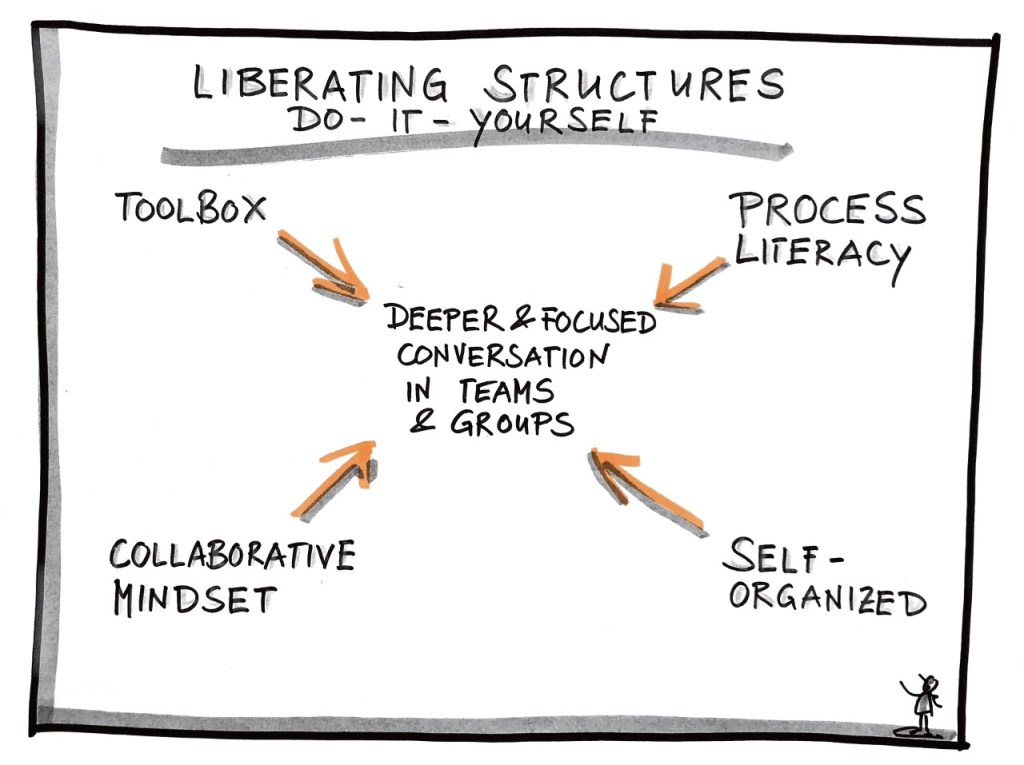Liberating Structures is a funny term. At least that is the reaction I get when I am telling about my Liberating Structures workshops. It seems that the term is not easily accessible outside of the Liberating Structures community. I often fail with my explanation that Liberating Structures is a set of methods (you could also call them structures, activities, interactions) to structure conversation and solution finding; and that these structures can be easily applied by everyone. Somehow that sounds quirky and abstract. So what?
In this blog post I test an entirely different approach.
It will be soon three years that I moved to the Netherlands. I discovered many new facets of living in this country. One is the enormous do-it-yourself culture. Every Dutch seems to be handy. Supply shops can be found at every corner and explanatory how-to videos show in a step-by-step approach how to repair a sink, hang wallpaper or install a pine wood floor. Do-it-yourself is a collaborative concept engrained in the Dutch living together. The day we got the key to our new home, the wider family was almost standing at the door dressed in overalls and equipped with ladder, brushes and a toolbox to get started with renovating our new home.
In a nutshell: The Dutch know how to renovate a house. They have a toolbox and know where to get the missing tool. They self-organize and follow a collaborative approach.
It is the same with Liberating Structures: Liberating Structures is a do-it-yourself concept for teams, groups, networks to work better together.
Toolbox
Liberating Structures offers of a toolbox containing 33 basic structures – some are small, others are big. All the structures are well explained and easily accessible through various channels: the website, an App, and the book. Additional structures in development are published. The toolbox is for everyone and adaptable for every context (conversation and reflection in teams, groups, networks, schools, family etc.).
The Liberating Structures toolbox is well presented, all the structures follow the same design element:
- a structuring invitation;
- how the space is arranged and what materials are needed;
- how participation is distributed;
- how groups are configured:
- a sequence of steps and time allocation.
Design elements from the Liberating Structures website
Know-how
With the help of the Matchmaker Matrix, everyone who is a bit handy and has some process knowledge will be able to select the right structure. As with the artisan’s toolbox there are various structures for different kind of conversations: Sharing ideas, know-how or experiences; generating ideas or solutions; analyzing and debriefing; getting or giving help; strategizing; and planning.
Advanced Liberating Structures artisans combine the structures to strings that allow a group to explore an issue in more in-depth. Support is available for all the others: There are introduction workshops, user groups and the global community on Slack helping any newcomer with advice and resources.
Collaborative approach
Liberating Structures supports collaboration and the sharing of responsibility. Through the sequence of steps, a conversation is guided, a team or a group gains focus and has more creative and richer conversations. Modern work life is blessed with many meetings. It is no luxury to invest in process knowledge and develop internal facilitation skills. For those who have the interest to experiment with the role of the facilitator, Liberating Structures is a great opportunity.

Leave a comment